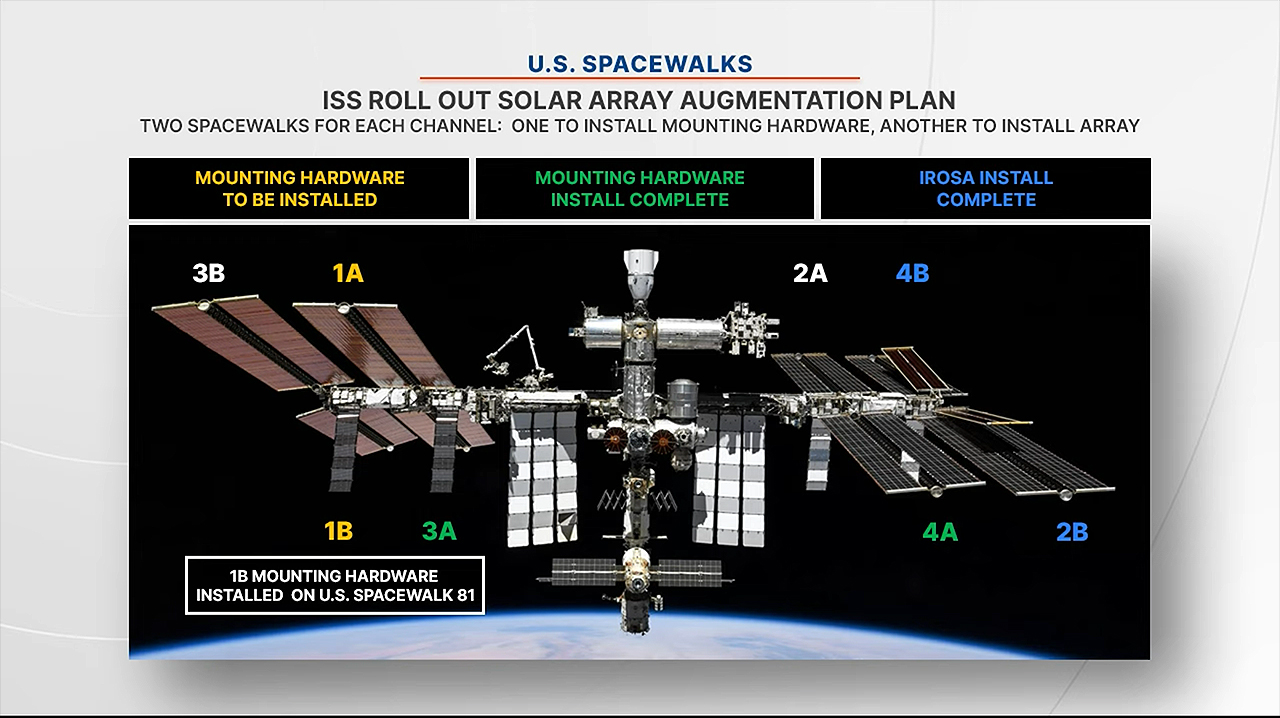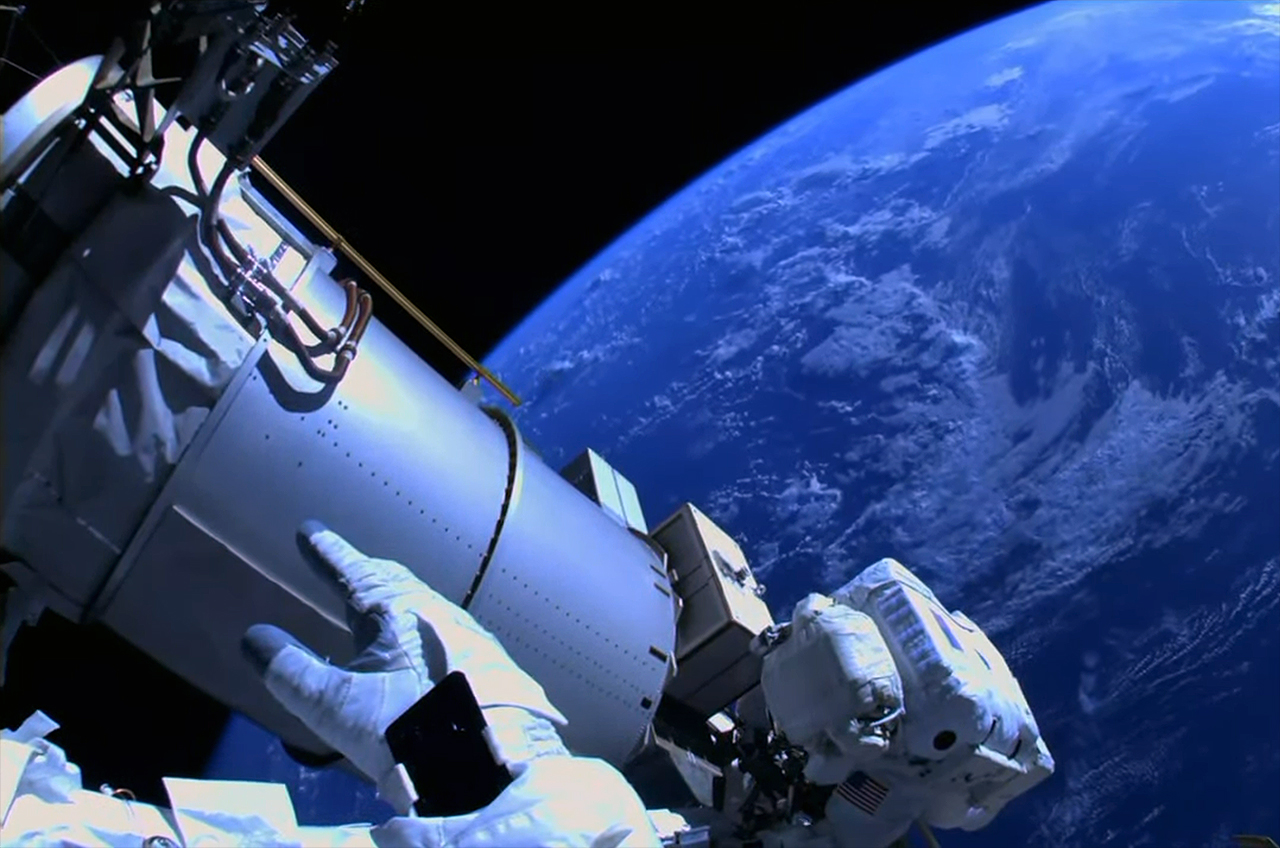Spacewalking NASA astronauts erect support frame for new ISS solar array
Josh Cassada and Frank Rubio spent seven hours working outside the International Space Station.

Two NASA astronauts completed the first in a series of three spacewalks to continue upgrading the power supply for the International Space Station (ISS).
Expedition 68 crewmates Josh Cassada and Frank Rubio worked together on Tuesday (Nov. 15) to prepare the exterior of the space station for the addition of two more upgraded solar arrays. Their extravehicular activity (EVA) was the sixth spacewalk since June 2021 to be dedicated to the new ISS Roll Out Solar Arrays, or iROSAs, which are augmenting the station's existing solar panel wings.
Cassada and Rubio began their EVA at 9:14 a.m. EST (1414 GMT), about an hour and 15 minutes later than originally planned. While getting ready to exit the station's Quest airlock, Cassada discovered a problem with the display on his spacesuit's control unit, which required the extra time to troubleshoot and correct.
Spacewalks: How they work and major milestones
Once outside, the two spacewalkers split ways to tackle separate tasks. Rubio went to work routing cables for the next iROSA to be installed on an EVA later this month, while Cassada got started on setting up for the installation of a modification kit to support another of the arrays.
"I was told I got to do a spacewalk with Frank, but I haven’t seen him today," joked Cassada. "Every time we run into each other, it's nighttime."
Once Rubio was done, he joined Cassada at the end of the station's starboard truss to assist in the major task of their spacewalk, the addition of iROSA mounting bracket for the 1A power channel. The hardware the two were installing arrived at the space station on Nov. 9 aboard the Northrop Grumman NG-18 Cygnus spacecraft, the S.S. Sally Ride.
Get the Space.com Newsletter
Breaking space news, the latest updates on rocket launches, skywatching events and more!
"The TBA bag is real hard to keep out of your face, I'll tell you that," radioed Cassada to Mission Control in Houston, describing a tool bag assembly that even though tethered seemed to want to obscure his view.
"Yeah, I see it. It has got a little mind of its own," replied astronaut Zena Cardman, who served as the CapCom (capsule communicator) supporting Tuesday's spacewalk.
"I keep trying to tuck it under my chin. It's not working," Cassada replied.
In addition to the bracket itself, the modification (or mod) kit included the struts Cassada and Rubio assembled to form a support frame for the new solar array. The spacewalkers were able to erect the frame, but due to the delay getting started with the spacewalk, had to forgo adding the collar bolts that secure the struts in place, as well as running cables to the assembly. Those tasks will be deferred to a future spacewalk.

To date, two of the six planned iROSA installations have been complete. After Tuesday's EVA, three more had their mounting hardware in place, leaving just one more to be done. Each of the new arrays is capable of generating 20 kilowatts of power. When used in tandem with the still-exposed areas on the older larger wings, the upgraded system will be capable of increasing the space station's electricity supply by 20 to 30%.
The iROSAs were developed and built by Deployable Space Systems, now part of the space infrastructure technology company Redwire, and were prepared for launch by Boeing. In addition to assuring the space station has enough power to support its future needs, including expanded commercial activities, the iROSAs also serve as a test for a similar set of roll-out solar arrays to be used at NASA's Artemis Gateway space station to be deployed in orbit around the moon.
The Gateway's ROSAs will be longer and deployed remotely, without astronauts present, but otherwise will use the same technology as the station's iROSAs.

Cassada and Rubio completed Tuesday’s spacewalk at 4:25 p.m. EST (2125 GMT), after spending 7 hours and 11 minutes outside the International Space Station. The EVA was the first for both crewmates.
The spacewalk was the ninth for the year, the first of at least seven planned for Expedition 68 and the 254th since 1998 in support of assembly and maintenance of the ISS.
Follow us on Twitter @Spacedotcom or on Facebook.
Join our Space Forums to keep talking space on the latest missions, night sky and more! And if you have a news tip, correction or comment, let us know at: community@space.com.

Robert Pearlman is a space historian, journalist and the founder and editor of collectSPACE.com, a daily news publication and community devoted to space history with a particular focus on how and where space exploration intersects with pop culture. Pearlman is also a contributing writer for Space.com and co-author of "Space Stations: The Art, Science, and Reality of Working in Space” published by Smithsonian Books in 2018.In 2009, he was inducted into the U.S. Space Camp Hall of Fame in Huntsville, Alabama. In 2021, he was honored by the American Astronautical Society with the Ordway Award for Sustained Excellence in Spaceflight History. In 2023, the National Space Club Florida Committee recognized Pearlman with the Kolcum News and Communications Award for excellence in telling the space story along the Space Coast and throughout the world.









